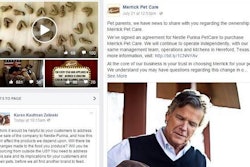Pet food companies and their involvement in sustainability and social causes—or questions about whether they’re involved enough—have been in the US news recently. First, the New York Times published an exposé on the slave trade underpinning the Southeastern Asia fish trade, which supplies some pet food and feed companies. The headline, “’Sea Slaves’: the Human Misery That Feeds Pets and Livestock,” bordered on the sensational but immediately gave the gist of the story.
Later that same week, Greenbiz.com posted an article by Marc Gunther about the carbon footprint of the pet food industry and what the larger companies, particularly Mars Pet Care, are doing to decrease their footprints, including Mars’ sourcing of fish-based ingredients. That was also discussed in the NY Times article by author Ian Urbina, and Nestlé Purina Pet Care’s practices received some coverage in both articles.
Then this week, Wellness Pet Food announced it is sponsoring a new TerraCycle recycling program that allows pet owners to recycle pet food bags in exchange for donations to a nonprofit of their choice. A new pet food company, Open Farm, launched earlier this year with a TerraCycle recycling program as part of its business model.
In fact, Open Farm goes beyond packaging recycling, basing its pet food brand on a Certified Humane claim that all of its products and the ingredients within them are “ethically raised and sourced.” This includes the use of humanely and sustainably farmed meats, exclusively ocean-caught, seasonally sourced fish (in collaboration with Ocean Wise and the Vancouver Aquarium) and locally grown vegetables.
Open Farm has the benefit of starting its brand at a time when sustainability in all its forms may be finally reaching a tipping point with companies and consumers. Regarding the latter, the 2015 Eco Pulse study from the Shelton Group showed that US consumers who named brands they loved often gave environmental and social responsibility reasons for their ardor, just as frequently as they cited core production functionality or performance features. Suzanne Shelton, founder and CEO of the Shelton Group, wrote on Greenbiz.com that the same was true for brands that consumers professed to hate.
More specifically, when asked, “Have you ever chosen one product over another or stopped purchasing a product based on the environmental record of its manufacturer?” 33% of the study respondents said yes, and 75% named a specific brand. Both percentages are up significantly in only a year and historically; in the 2014 Eco Pulse study, just 11% said yes and 51% named a specific brand.
We also know that this type of data on consumer attitudes toward sustainability and brands is likely to keep trending upward as Millennials overtake Baby Boomers, as they already have among US pet owners. Many sources say Millennials are much more likely than other demographic groups to purchase brands that support a cause they care about, either environmental or social.
As for pet food manufacturers, many have been adopting alternative energy sources to power their plants and offices, in addition to promoting recycling programs and following sustainable ingredient sourcing practices such as those discussed in Gunther’s Greenbiz.com article. These measures all help companies reduce costs, especially as alternative energy becomes more affordable and recycling goes mainstream. Even for companies that don’t seem to care about “hugging trees” or saving the planet, saving money is always a powerful motivator.
Yet all of this movement does not mean the majority of consumers are willing to pay more to purchase brands or products that support environmental or social causes; nor are their attitudes and purchasing behavior always in sync with companies striving to do so. In the Greenbiz.com article, Gunther referred to comments from Isabelle Alvoet, global sustainability director for Mars, about her company’s progress toward sustainable seafood use. “This is a challenge for the company, she explained, because it runs counter to the desires of customers: Pet owners increasingly want to buy food for their pets that resembles what they eat,” Gunther wrote.
Humanization of pets, with owners wanting to feed their pets so similarly to how they feed themselves and their human family members, also has a lot to do with the myths and misperceptions about the use of meat by-products and other ingredients in pet food.
Similarly, in terms of human rights cases such as that raised by the NY Times article on the slave trade in the fishing industry, US and other Western consumers tend to ignore the “labor that supplies the seafood that people eat, much less the fish that is fed to animals,” Urbina wrote. Then he quoted Giovanni M. Turchini, an environmental professor at Deakin University in Australia who studies the global fish markets: “How fast do their pets eat what’s put in front of them, and are there whole meat chunks in that meal? These are the factors that pet owners most focus on.”
















